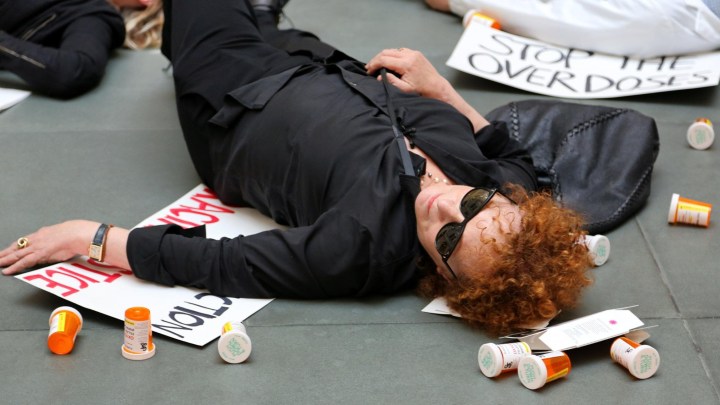
Art as commodity versus art as protest

Subscribe to our Econ Extra Credit newsletter to get essays like this delivered to your inbox every week.
Photographer and activist Nan Goldin’s campaign against the Sackler family — owners of Purdue Pharma, who knowingly marketed the addictive painkiller OxyContin — was effective because of her use of repetition.
Repetition is the “most basic and effective rhetorical device, as Donald Trump and Purdue Pharma’s sales reps fully grasp,” investigative reporter Christopher Glazek wrote in Artforum.
Throughout the documentary “All the Beauty and the Bloodshed,” viewers see Goldin and her colleagues from Prescription Addiction Intervention Now protest at several of the world’s most famous art museums. She targeted them for accepting philanthropic donations from the Sacklers, allowing the family to burnish their name as patrons of the arts rather than contributors to the opioid epidemic.
The simplicity and success of Goldin’s protests aimed at pressuring museums to remove the Sackler name from their halls got us at “Econ Extra Credit” thinking about the interplay among capitalism, power, art and activism. Let’s dive in.
The idea that commerce and culture should be separate is a popular one, epitomized by the phrase “art for art’s sake.”
Many artists have sought to separate the business of surviving — having enough money to pay for housing and food — from the intention or message behind their artistic work. (Andy Warhol, on the other hand, did not see an inherent conflict between the two. He once wrote, “Making money is art and working is art and good business is the best art.”)
In Western economies, most professional artists seek to sell their work to collectors or museums. Works of art can serve a religious, social or purely aesthetic function, but they are also commodities, objects that can be bought and sold.
Some art resists commodification: a community mural or ephemeral performance art. Think of the “Man” at Burning Man. And sometimes artistic value and monetary value can conflict. The artist’s reason for creating a symbolic or political work may be undermined by the art market, especially its wealthier participants, who may treat the work merely as a means to an end — they buy the art solely to sell it for more money.
And artists often have little control over the monetary value of their work, although many try. After a Banksy painting sold for $1.4 million in 2018, the artist tried to destroy the piece. The shredded version of “Girl With Balloon” sold for $25.4 million three years later.
“There are some paradoxical cultural commodities whose message or content — their use-value — is at odds with, or critical of, their status as commodities,” art critic and historian John Walker wrote in Circa Art Magazine in 1987.
Nan Goldin was seemingly aware of that paradox. By protesting galleries and museums that did business with Purdue Pharma’s Sackler family, she was challenging the same institutions that supported her livelihood. To call out the art world for participating in “artwashing” could have destroyed her career as a professional artist. She chose to act anyway.
“I’m incapable of being a good bourgeois person,” Goldin said in an interview.
She has continued to stage protests and “die-ins,” most recently in April at Harvard University, which has not removed OxyContin magnate Arthur Sackler’s name from one of its museums.
When the arts publication Frieze asked a group of artists, “How important is art as a form of protest?” it received 50 responses from 30 countries. The answers sometimes overlapped with and contradicted one another.
Visual artist Walead Beshty was skeptical of artists’ ability to use their work to protest injustice because of its commodification. He wrote: “In the moments that necessitate protest, the voice of art is insufficient at best and oppositional at worst: for, the institutional system through which it speaks is the very thing that protest questions.”
But performance artist David Birkin saw it differently. “Artists, like journalists and activists, need to define the truth and defend it,” he wrote.
“We shouldn’t be afraid to be polemical. We all have a dog in this fight. Or, if we don’t, we should be supporting people who do. … We cannot separate ethics from aesthetics.”
Goldin, as both a photographer and an opioid overdose survivor, answered that call to defend truth. And for her, that truth is: “Sacklers lie, thousands die.”
“All the Beauty and the Bloodshed” is available to stream on Max and DirectTV Stream with a subscription and on Kanopy for some library card holders. It’s also available to buy or rent on Vudu, Apple TV+ and Prime Video.
Have you watched the film? Send us your questions and thoughts by replying to this email or sending us a note to extracredit@marketplace.org.
There’s a lot happening in the world. Through it all, Marketplace is here for you.
You rely on Marketplace to break down the world’s events and tell you how it affects you in a fact-based, approachable way. We rely on your financial support to keep making that possible.
Your donation today powers the independent journalism that you rely on. For just $5/month, you can help sustain Marketplace so we can keep reporting on the things that matter to you.


















